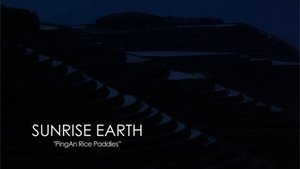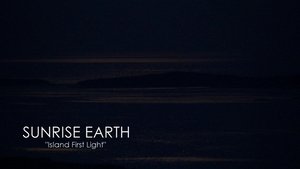This program records the events of one total solar eclipse, that of March 29th, 2006 as it happens in two locations on the planet. We travel to Natel, Brazil (at the beginning of the eclipse) and observe a group of fishermen and wild native species along an open stretch of beach. We then shift to Antalya, Turkey (for the mid-point of the eclipse) and observe a peaceful village as the moon makes it's way across the sun. ** Possible duplicate of 1x52 **
Venice, Italy Many have called this Old World maritime center the most beautiful city on earth. Millions visit each year, attracted by the image of a romantic sunset serenade on a gondola while dreamily floating down on the Grand Canal. Dawn offers its own distinctive window into this city's character, long before the gondolas awake. This episode departs from the fixed vantage points of past Sunrise Earth shows. For the first time, we take a voyage by slow-moving boat. We do our best to get lost within the 28 miles of the Venetian canal system. A mesmerizing passage into the Cannaregio district reveals the lesser-known beauty behind the city's famous glitz. Workboats slip under low bridges and their even lower hanging verdant plants. Cool yellows and pinks catch the morning sun and betray the Santa Maria dei Miracoli and some of the world's finest marble stonework. Window shutters are opened by sleepy-eyed Italians, startling the pigeons, which roost along the narrow waterways at night. We silently pass the sites where famous Venetians once awoke each day; such as the great Renaissance painter Tintoretto and the Orient explorer Marco Polo. Fishermen motor by, on their way to the open air market in the Rialto, with over 100 varieties of fish. Caught amidst the tension of the moving and the still, the beauty of Venice is sustained for another day.
Dawn pierces a lavender sky on the South Island of New Zealand. We are alongside a serene glacial lake in the Southern Alps, called Lake Wakatipu, and are entirely ringed by looming mountains. These high ranges betray the story of the collision of continental plates as schist "tors" border spires of metamorphic rock. It is a storybook vista. In fact, the beech forests along the lake were filmed for "The Lord of the Rings." At lake level, delicate hoarfrost nightly coats grasses and plants. As the sun ascends, light sparks in a fairyland of ice crystals. The indigo sky blooms into yellow dawn. Warmth invades the braided river system of shallow sandbars and flats, as paradise shelducks graze on clover and weed seeds. The shy dunnock or hedge sparrow pecks among the pebbles. Hoarfrost melts in the rising sun - a winter's day begins, at the bottom of the world - in "Middle Earth."
Tambopata, Peru Two hundred feet high in the canopy of Peruvian rainforest, a pink and distant light encroaches. The dense forest holds the dawn air. Birds sing alone, together - a purple-throated cotinga, then a distant flycatcher. Butterflies gather nectar. The high canopy teems with insects - oblivious as the sun ascends. Rosy light splashes the sky. The sun pushes its way into the forest. A blue-headed parrot busies herself collecting twigs for her nest. A cobalt-winged parakeet pulls at the white seed masses of a kapok tree - feeding and pollinating at the same time. As the sun rises overhead, we slowly descend into the tangled under story. Orchids and epiphytes bob in the moist air. Complex partnerships between insects, birds and plants play out amongst an eden of species. Aricaris - brown mandibled and curl-crested toucans - chase insects. Descending farther, we land on the forest floor amongst broad-leaved plants and a nation of insects - lines of foraging ants, wandering ground beetles, a jumping spider. The fervent life of the rainforest is revealed in a slow drift downwards to the forest floor.
Siem Reap, China Every culture has its own connection to the natural world at dawn. In Siem Reap, Cambodia, the chants of monks echo from within a Theravada Buddhist monastery, called a "wat." These chants help start the day by focusing the monks' attention. Potential distractions are many. Unlike the cloistered monastic retreats of the west, the Wat Svay compound is at the community hub, at its central cross-road. Yet despite busy human activity, the peaceful influence and presence of the natural world remains near for the focused mind. A vibrant pigeon roost is found on the pagoda's rooftop, amidst ornamental carvings that depict serpent figures called "nagas," protectors from the earth. School children wander among the votive "stupas," maintaining the grounds. And as the monks honor their lineage of spiritual teachers, a spectacular rainbow reveals itself high over the temple. One last little know fact…a rainbow at sunrise will always have a steeper arc than any rainbow that happens near mid-day.

Frogs, spiders, and birds wake to the morning sun on a terraced farm near PingAn, China. Take in the morning activities of the Dragon's Backbone, a stunning sixty-six square kilometers of crop terraces hand-cultivated by 800 farmers that snake up over a thousand feet of vertical altitude. These are marks of the Zhuang people.
La Paz River, Vara Blanca, Costa Rica — The crater lake of the Poas Volcano drains from 9,000 feet into this high altitude cloudforest ravine. Stepping downward through a series of five waterfalls, we descend as the sun rises. Rays of light catch suspended water particles from the falling water, as green threads of life cling to sodden cliff walls. From within its pupa, an owl butterfly emerges with the increasing warmth of day, pumping fluid into its silken wings. Through the last rock opening, the water and sun burst out and down towards a restful pool, the famous La Paz waterfall.
Western U.S. — Crossing the North American continent in a scant four hours, dawn settles on the Great Plains, the Rocky Mountains, and the coastal ranges and beaches of California before departing the western shore. We witness the geo-dramas of Yellowstone geysers, herds of horses and bison on the open range, the spectacular lighting of the Teton Range. Then in California, we see the massive sequoia, tule elk, a rainbow of wildflowers, the Yosemite Valley, and elephant seals on the beach. These are the great sunrise moments in nearly a dozen morning ecosystems of the west.
Eastern U.S. — The sun hits the Atlantic seaboard five hours after the western coast of Europe, and a wide range of habitats begin the shift from the nocturnal to the heat and light of day. We observe the changes, as naturalists, from the sub-tropical ecosystem of the Everglades to the northern lakes of New England, from the very first light atop Cadillac Mountain in Maine to the sabal palms of the Gulf of Mexico. These are great sunrise moments in nearly a dozen morning ecosystems of the East.

Cadillac Mountain, Acadia National Park, Maine — At 1,532 feet, this is the highest vantage point along the North Atlantic seaboard. During certain times of year, the summit receives the rays of the first rising sun within the United States. The pea, composed of pink granite, is perched above a forest of spruce and pitch pine. Among the granite slabs are tiny sub-alpine plants such as cinquefoil, squat, gnarled trees, wild blueberries and various sized boulders. The view of the Maine archipelago is unsurpassed, with the Cranberry Islands foremost in the southwest.
Schwabacher's Landing, Moose, Wyoming — The nocturnal beavers have settled into a small tributary under the sheer cirque walls, rugged ridges and jagged peaks of the Teton Range. Their engineering skill has produced an 8-foot high dam and a new pond for those creatures of the day: a great blue heron fishing in the morning mist, ducks with their ducklings, trout, and a goldfinch feeding her chick. We witness these two communities as they pass each other during the crossroad of dawn.
Pahayokee, Everglade National Park, Florida. Savannah-like open sawgrass prairie stretches as far as the eye can see, punctuated by the occasional cypress tree. Beneath the apparent prairie, however, is a wide river flowing at a speed of more than one mile per hour. It's Marjorie Stoneham Douglas' famous "River of Grass." In fact this exact Pahayokee platform was this writer's most frequented Everglade destination. To better observe the workings of the underwater world, we submerge a camera and peer directly into the lives of mosquito fish and the enriching mat-like algae known as periphyton. Insects traverse the razor sharp strands of grass as the weather changes.